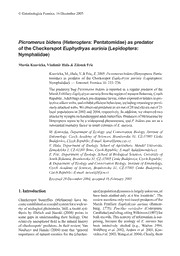
Picromerus bidens (Heteroptera: Pentatomidae) as predator of the Checkerspot Euphydryas aurinia (Lepidoptera: Nymphalidae) PDF
Preview Picromerus bidens (Heteroptera: Pentatomidae) as predator of the Checkerspot Euphydryas aurinia (Lepidoptera: Nymphalidae)
©EntomologicaFennica.16December2005 Picromerus bidens (Heteroptera: Pentatomidae) as predator of the Checkerspot Euphydryas aurinia (Lepidoptera: Nymphalidae) MartinKonvicka,VladimirHula&ZdenekFric Konvicka,M.,Hula,V.&Fric,Z.2005:Picromerusbidens(Heteroptera:Penta- tomidae) as predator of the Checkerspot Euphydryas aurinia (Lepidoptera: Nymphalidae).—Entomol.Fennica16:233–236. The predatory bug Picromerus bidens is reported as a regular predator of the MarshFritillaryEuphydryasauriniafromtheregionofwesternBohemia,Czech Republic.Adultbugsattackpre-diapauselarvae,eitherexposedorhiddeninpro- tectivesilkenwebs,andexhibitefficientbehaviour,includingreturningtoprevi- ouslyattackedwebs.Weobservedpredationinsixoutof28andelevenoutof21 localpopulationsin2003and2004,respectively.Inaddition,weobservedtwo attacksbynymphsonhandicappedadultbutterflies.PredationofMelitaeinaeby Heteropteraseemstobeawidespreadphenomenon,andP.bidenscanactasa substantialmortalityfactorinsmallcoloniesofE.aurinia. M. Konvicka, Department of Ecology and Conservation Biology, Institute of Entomology, Czech Academy of Sciences, Branisovska 31, CZ-37005 Ceske Budejovice,CzechRepublic;E-mail:[email protected] V. Hula, Department of Zoology, School of Agriculture, Mendel University, Zemedelska1,CZ-61301Brno,CzechRepublic;E-mail:[email protected] Z. Fric, Department of Zoology, School of Biological Sciences, University of SouthBohemia,Branisovska31,CZ-37005CeskeBudejovice,CzechRepublic; &DepartmentofEcologyandConservationBiology,InstituteofEntomology, Czech Academy of Sciences, Branisovska 31, CZ-37005 Ceske Budejovice, CzechRepublic;E-mail:[email protected] Received29December2004,accepted16February2005 1.Introduction spot]populationdynamicsislargelyunknown,or havebeenstudiedonly atafewlocations”.The Checkerspot butterflies (Melitaeini) have be- reviewmentionsonlytwoinsectpredatorsofthe comeestablishedasamodelsystemforawidear- Marsh Fritillary Euphydryas aurinia (Rottem- rayofecologicalphenomena.Still,arecentsyn- burg, 1775): Poecilus versicolor (Coleoptera: thesis by Ehrlich and Hanski (2004) points to Carabidae)andabug,citingWilkinson(1907)for some gaps in understanding their biology. One bothrecords.Thisscarcityofinformationissur- relatively unexploredfieldisthenaturalhistory prising, because the ecology of E. aurinia has of checkerspots’predators. In their review, Van been intensively studied (e.g., Warren 1994, Nouhuys and Hanski (2004) state that “general Wahlberg et al. 2002, Anthes et al. 2003, Kon- importanceofnaturalenemiesfor the[checker- vickaetal.2003,Wangetal.2004).Clearly,there 234 Konvickaetal. (cid:127) ENTOMOL.FENNICAVol.16 stillisaneed“tofurtherstudythenaturalhistory quireadifferentmethodofsearchesthanjustzig- andhostrangesofthepredatorsandparasitoids” zagging the localities. Therefore, we only re- (VanNouhuys&Hanski2004). cordedifwehadobservedpredationpersite,and Wereporthereourobservationsofpredation sowedonotknowtheexactnumbersofthepre- bythebugPicromerusbidens(Linnaeus,1758) dationoccasionsbythebugs. on both pre-hibernation larvaeand adult butter- fliesofE.aurinia. 3.Results 2.Materialandmethods 3.1.Predationonlarvae The distribution of E. aurinia in the Czech Re- Predation by the bug was observed every year, publicisrestrictedtowesternBohemia,whereit butrecordedindetailonlyin2003and2004.At- forms relatively small local populations (”colo- tacksbythebugwereobservedatsixoutof28oc- nies”)restrictedtowetmeadowsandnon-inten- cupiedcoloniesin2003(21%),andatelevenout sivepastures.Closelyadjoiningcoloniesarein- of21coloniesin2004(52%).Thecolonieswere terconnected by adult dispersal and exhibit a typically medium- to large-sized (> 20 larval metapopulation dynamics (Hula et al. 2004). webs),butinonecasein2004,weobservedpre- AdultbutterfliesareonwingsfromlateMayuntil dationwithinanisolatedandextremelysmallcol- lateJune.Femaleslaybatchesofeggsonleaves ony(19kmfromtheclosestsite,sixlarvalwebs). ofSuccisapratensis,andlarvaefeedonthatplant The bugs attacked both exposed caterpillars communally in loose silk-woven nests until hi- and,particularlyincoolerdays(<15°C,overcast bernation. Prior to hibernation, they form more sky),inactivecaterpillarshiddeninsilkenwebs. compacthibernationnests.Posthibernationlar- When feeding on exposed caterpillars, the bug vaelivesolitarily. typically approached the larval mass, stalked a We have studied the species from 2002 on- larva with proboscis, walked a few centimetres wards,applyingannualcountsoflarvalwebsat away and sucked with its proboscis protruding all known sites, combined with mark-recapture onwards (Fig. 1). The larvae tried to escape by counts ofadults within asystemofseven inter- wigglingtheirbodies,butoutofsomefiftyobser- connected colonies (Hula et al. 2004). Annual vations, the efforts never succeeded. After con- numbersofoccupiedcoloniesrangedfrom21to sumingtheprey,thebugtypicallyreturnedtothe 28(mean=23.3),theirsizesrangedfromsingle larvalgroupandsingledoutanothercaterpillar.In nesttoaboutonehundrednests(withannualme- dians between ten and twenty nests). Annual numbers of adults and larval webs exhibited a closecorrelation. Theobservationsofpredationoflarvaeorigi- nated during counts of larval webs, conducted eachyearduringthefirstweekofSeptember.Vis- iting all colonies takes about a week. The time spentatonecolonysitevariesfromtwentyper- son-minutestoaboutfiveperson-hours,depend- ingoncolonysize.Theattacksonadultswereob- servedduringthemark-recapturestudies,which consistedofdailymarkingofbutterfliesbyoneto threepersons,coveringtheentireadultflightpe- riod(detailsinHulaetal.2004). Fig.1.AdultPicromerusbidenspreyingonlarvaof Theautumncountsoflarvalwebswerecon- Euphydryasaurinia.Notethesilkenmeshingoflarval ductedtomonitorpopulationchangesandwedid webintheright.EnvironsofKarlovyVary,westernBo- notrecordtheexactnumbersofbugs.Itwouldre- hemia,2September2003.©V.Hula. ENTOMOL.FENNICAVol.16 (cid:127) HeteropteranpredatorofEuphydryasaurinia 235 Fig.2.NymphofPicromerusbidens feedingonadultEuphydryasaurinia. Thebutterfly,stillalive,washanging fromaspiderweb.Bochovnear KarlovyVary,westernBohemia,18 June2003.©V.Hula. onecase,weobservedfivesuchreturns.Whenat- important food source in early autumn, when tackinglarvaehiddenintheweb,thebugfirstex- onlyafewlarvaeofotherspeciesoccurinhigh ploredwebsurface,tryingtolocateanopening. densities. The bug attacks the larvae quite effi- Inthreecases,itpuncturedtheencasingsilkand cientlyandvisitsasinglelarvalgrouprepeatedly. pokeditsprobosciswithinthewebforafewsec- Hence,itmightactasasubstantialmortalityfac- onds, until it pierced a larva. One larval group tor.Althoughitisunlikelytobeathreattothesur- wasusuallyattackedbyasinglebug,butinone vivaloflargecolonies,itmightdepletesmallpop- case,threebugsexploitedoneweb. ulations,suchastheoneconsistingofsixlarval webs.Weobservedattackedadultbutterfliesonly whendamagedoralreadyentrapped. 3.2.Predationofadults Predationby Heteropterahasbeenobserved in other Melitaeini as well. Van Nauhuys and Observed twice, in both cases on handicapped Hanski(2004)listpredationonneonateEuphy- butterflies.In2003,anymphofthebugstalkeda dryas gilletti (Barnes, 1897) by unspecified butterflythatlooselyhangedfromalow-situated Miridae,andpredationonMelitaeacinxia(Lin- spider’sweb,stilltryingtoescape.Wecaptured naeus,1758)byPentatomidae.VrabecandJindra the bug while it fed on the butterfly and photo- (1998) reported substantial larval mortality of grapheditwhilefeeding(Fig.2).In2004,ween- Euphydryasmaturna(Linnaeus,1758)causedby countered a nymph sucking on a male butterfly Picromerusbidens. thatwaswornsoheavilythatitwasunabletofly. Themajorityofcheckerspotspeciesdevelop onplantscontainingiridoidglycosidesor(asin the case of E. aurinia that feeds on Succisa 4.Discussion pratensis)secoiridoids,whichtheysequesterfor their defence (Wahlberg 2001, Suomi et al. Picromerusbidensisageneralisedpredatorofa 2003).AlthoughthedistastefullnessofE.aurinia wide range of insects, including hymenopteran, wasnotyetconclusivelyassayed,supportivein- coleopteranandlepidopteranlarvae(Larivière& dicesincluderelativelyslowflight,fakingdeath Larochelle1989,Volkov&Tkacheva1997).For when handled, aposematically coloured last- suchageneralist,larvaeofE.auriniarepresentan instar larvae and pupae, and larval gregarious- 236 Konvickaetal. (cid:127) ENTOMOL.FENNICAVol.16 ness. P. bidens seems to be able to overcome —Entomol.News100:133–146. lepidopteran chemical defences (Sirepinska Naumann,C.M.,Tarmann,G.M.&Tremewan,W.G. 1999:TheWesternPalaearcticZygaenidae(Lepidop- 1998, Vrabec & Jindra 1998, Naumann et al. tera).—ApolloBooks,Stenstrup.304pp. 1999,Stefanescu&Ribes2000,Dantart2003).It Sirepinska,A.1998:TowardsanIntegratedManagement would be fascinating to study whether this bug of Dendrolimus pini L. — In: McManus, M. L. & andotherpredatorypentatomids(cf.Hamilton& Liebhold, A. M. (eds.), Population Dynamics, Im- Heath1976)actuallypreferchemicallyprotected pacts,andIntegratedManagementofForestDefoliat- ingInsects.ProceedingsofConferenceheldinBanska Lepidoptera and employ their protective com- Stiavnica,Slovakia,inAugust18–23,1996.Onlineat poundsfortheirowndefence,similarlytosome http://www.iufro.org/iufro/iufronet/d7/wu70307/bans phytophagous Heteroptera that sequester plant ka/ toxins(Aldrichetal.1997,Tullbergetal.2000). Stefanescu,C.&Ribes,J.2000:Unalarvad’Iphiclides podalirius(Lepidoptera:Papilionidae)depredadaper Acknowledgements.WethankO.NedvedandL.Zahla- Picromerusbidens(Heteroptera:Pentatomidae,Aso- vovaforusefulsuggestions,MatthewSweneyforcorrect- pinae).—Butll.Soc.Cat.Lep.86:33–35. ingourEnglish,andtwoanonymousrefereeswhosecom- Suomi, J., Siren, H., Jussila, M., Wiedmer, S. K. & mentssubstantiallyimprovedthequalityofourpaper.Our Riekkola,M.L.2003:Determinationofiridoidglyco- fieldworkatE.auriniasiteswassupportedbytheCzech sidesinlarvaeandadultsofbutterflyMelitaeacinxia AcademyofSciences(B6007306/2003)andbytheGrant bypartialfillingmicellarelectrokineticcapillarychro- AgencyoftheCzechRepublic(206/03/H034). matography-electrosprayionisationmassspectrome- try.—Anal.Bioanal.Chem.376:884–889. Tullberg,B.S.,Gamberale-Stille,G.&Solbreck,C.2000: References Effectsoffoodplantandgroupsizeonpredatorde- fence: differences between two co-occurring apo- sematicLygaeinaebugs.—Ecol.Entomol.25:220– Aldrich,J.R.,Leal,W.S.,Nishida,R.,Khrimian,A.P., 225 Lee,C.J.&Sakuratani,Y.1997:Semiochemistryof VanNauhuys,S.&Hanski,I.2004:Naturalenemiesof aposematicseedbugs.—Entomol.Exper.Appl.84: Checkerspots.—In:Ehrlich,P.R.&Hanski,I.(eds.), 127–135. Onthewingsofcheckerspots:Amodelsysteminpo- Anthes, N., Fartmann, T., Hermann, G. & Giselher, K. pulationecology:161–180.OxfordUniversityPress, 2003:Combininglarvalhabitatqualityandmetapopu- Oxford.371pp. lationstructure–thekeyforsuccessfulmanagement Volkov,O.G.&Tkacheva,L.B.1997:Anaturalenemyof ofpre-alpineEuphydryasauriniacolonies.—J.Insect the Colorado potato beetle –Picromerus bidens. — Conserv.7:175–185. ZashchitaKarantinRastenii3:30[InRussian.] Dantart, J. 2003: Erugues d’Inachis io (Lepidoptera: Vrabec,V.&Jindra,Z.1998:Thecaterpillarsoftherare Nymphalidae, Nymphalinae) depredades per Picro- butterfly Euphydryas maturna (Lepidoptera: Nym- merusbidens(Heteroptera:Pentatomidae,Asopinae). phalidae)as food forthe predatory bug Picromerus —Butll.Soc.Cat.Lep.90:21–23 bidens(Heteroptera:Pentatomidae).—Entomol.Pro- Ehrlich,P.R.,&Hanski,I.2004:Onthewingsofchecker- bl.29:87–90. spots:Amodelsystemforpopulationbiology.—Ox- Wahlberg,N.2001.Thephylogeneticsandbiochemistry fordUniversityPress,Oxford.371pp. ofhost-plantspecializationinMelitaeinaebutterflies Hamilton, I. & Heath, J. 1976: Predation of Pentatoma (Lepidoptera:Nymphalidae).—Evolution55:522– rufipes(L.)(Hemiptera:Pentatomidae)uponZygaena 537. filipendulae(L.)(Lepidoptera:Zygaenidae).—The Wahlberg,N.,Klemetti,T.&Hanski,I.2002:Dynamic IrishNaturalist18:337. populationsinadynamiclandscape:themetapopula- HulaV.,KonvickaM.,PavlickoA.&FricZ.2004:Marsh tion structure of the Marsh fritillary butterfly. — Fritillary(Euphydryasaurinia)intheCzechRepublic: Ecography25:224–232. Monitoring,metapopulationstructure,andconserva- Wang,R.J.,Wang,Y.F.,Chen,J.J.,Lei,G.C.&Xu.R.M. tionoftheendangeredbutterfly.—Entomol.Fennica 2004:Contrastingmovementpatternsintwospecies 15:231–241. of chequerspot butterflies, Euphydryas aurinia and Konvicka,M.,Hula,V.&Fric,Z.2003:Habitatofpre-hi- Melitaeaphoebe,inthesamepatchnetwork.—Ecol. bernatinglarvaeoftheendangeredbutterflyEuphy- Entomol.29:367–374. dryasaurinia(Lepidoptera:Nymphalidae):Whatcan Warren,M.S.1994:TheUKstatusandsuspectedmeta- belearnedfromvegetationcompositionandarchitec- populationstructureofathreatenedEuropeanbutter- ture?—Eur.J.Entomol.100:313–322. fly,theMarshFritillaryEurodryasaurinia.—Biol. Larivière, M. C. & Larochelle, A. 1989: Picromerus Conserv.67:239–249. bidens(Heteroptera:Pentatomidae)inNorthAmerica, Wilkinson, G. 1907: Habits and habitat of Melitaea withaworldreviewofitsdistributionandbionomics. aurinia.—Entomol.Rec.J.Var.19:273–275.
